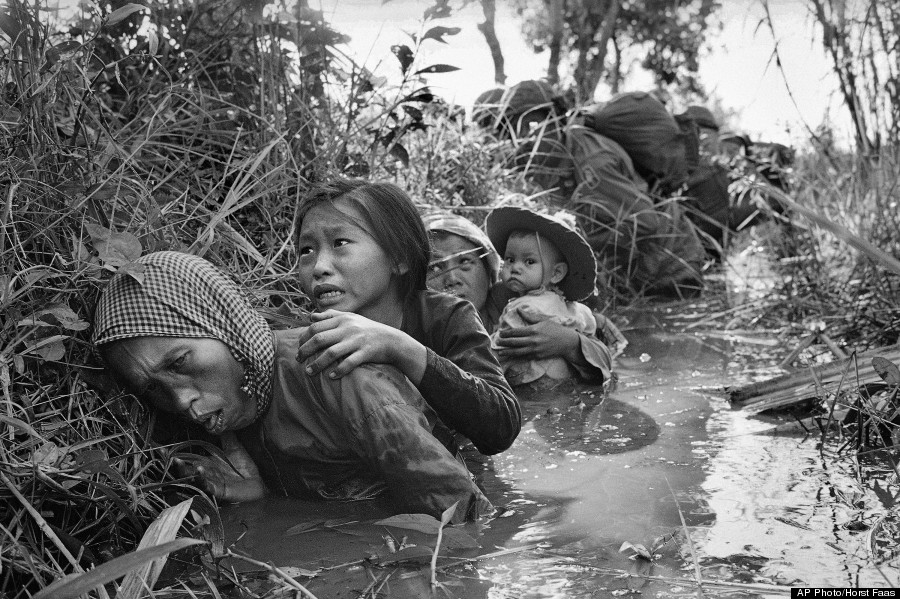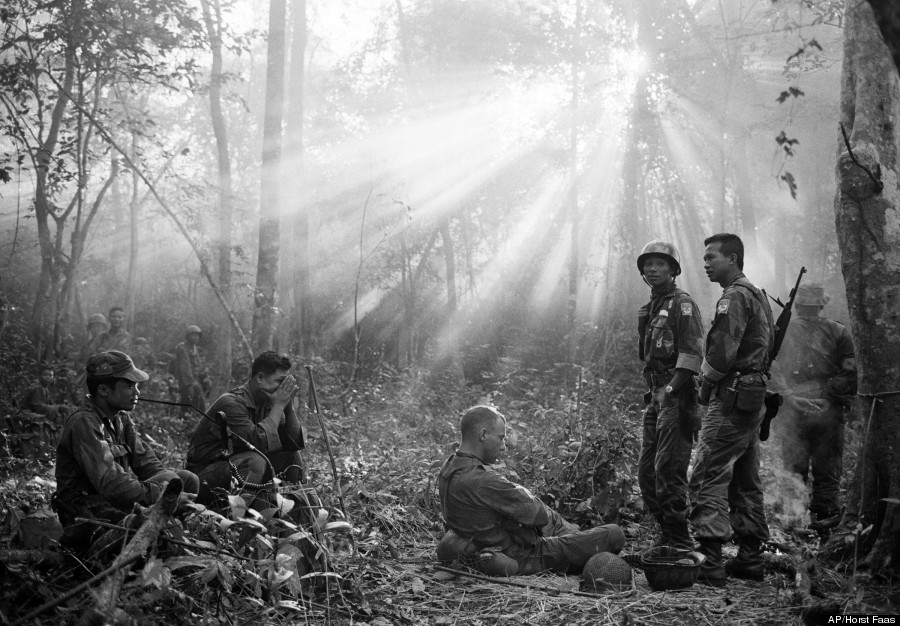'Vietnam: The Real War' - Iconic Images Published In New Book By Associated Press (GRAPHIC PICTURES)
Associated Press (AP) have published a new book called Vietnam: The Real War, containing over 300 powerful images to mark the 50th anniversary of the conflict.
Published
today, the book contains images of candid moments from the war chosen
from over 200,000 AP photos, from front-line combat to Buddhist Monks
committing self-immolation in protest.
The images changed public
perception of the war. Photos, rather than video footage, were key in
conveying to audiences around the world the brutality of the war in
Vietnam. Video cameras were being used by journalists in Vietnam but
lacked the impact of the small 35-millimetre camera, the tool of choice
for photojournalists.
 Women
and children crouch in a muddy canal as they take cover from intense
Viet Cong fire, January 1, 1966. Paratroopers of the 173rd Airborne
Brigade (background) escorted the civilians through a series of
firefights during the U.S. assault on a Viet Cong stronghold at Bao
Trai, about twenty miles west of Saigon.
Women
and children crouch in a muddy canal as they take cover from intense
Viet Cong fire, January 1, 1966. Paratroopers of the 173rd Airborne
Brigade (background) escorted the civilians through a series of
firefights during the U.S. assault on a Viet Cong stronghold at Bao
Trai, about twenty miles west of Saigon.
 An
unidentified American soldier wears a hand-lettered slogan on his
helmet, June 1965. The soldier was serving with the 173rd Airborne
Brigade on defense duty at the Phuoc Vinh airfield.
Vietnam: The Real War carries
an introduction from Pete Hamill, who reported from Vietnam in 1965:
“Across the years of the war in Vietnam, the AP photographers saw more
combat than any general.
“This book shows how good they were. As a
young reporter, I had learned much from photographers about how to see,
not merely look.
"From Vietnam, photographers taught the world
how to see the war. Say the word ‘Vietnam’ today to most people of a
certain age; the image that rises is usually a photograph.”
The
book includes AP journalist Malcolm Browne’s shocking photo of a
Buddhist monk taking his own life in petrol-fueled flames on a Saigon
street in 1963, protesting the policies of the United States-backed
South Vietnamese regime.
When President John F. Kennedy saw the
photo of the burning monk, he reportedly remarked, “We’ve got to do
something about that regime.”
An
unidentified American soldier wears a hand-lettered slogan on his
helmet, June 1965. The soldier was serving with the 173rd Airborne
Brigade on defense duty at the Phuoc Vinh airfield.
Vietnam: The Real War carries
an introduction from Pete Hamill, who reported from Vietnam in 1965:
“Across the years of the war in Vietnam, the AP photographers saw more
combat than any general.
“This book shows how good they were. As a
young reporter, I had learned much from photographers about how to see,
not merely look.
"From Vietnam, photographers taught the world
how to see the war. Say the word ‘Vietnam’ today to most people of a
certain age; the image that rises is usually a photograph.”
The
book includes AP journalist Malcolm Browne’s shocking photo of a
Buddhist monk taking his own life in petrol-fueled flames on a Saigon
street in 1963, protesting the policies of the United States-backed
South Vietnamese regime.
When President John F. Kennedy saw the
photo of the burning monk, he reportedly remarked, “We’ve got to do
something about that regime.”
 In
the first of a series of fiery suicides by Buddhist monks, Thich Quang
Duc burns himself to death on a Saigon street to protest persecution of
Buddhists by the South Vietnamese government, June 11, 1963. The
photograph aroused worldwide outrage and hastened the end of the Diem
government. With the photo on his Oval Office desk, President Kennedy
reportedly remarked to his ambassador, “We’re going to have to do
something about that regime.”
Also included is
the traumatic depiction of napalm attacks and the impact that
chemical-based weapons had on civilians, including AP’s Nick Ut photo
showing a scorched, naked girl fleeing a napalm attack.
Ut said of the girl in his famous picture "I cried when I saw her running, if I don't help her - if something happened and she died - I think I'd kill myself after that."
The photographer's older brother was reportedly killed on assignment with the AP in the southern Mekong Delta.
Nine years later, President Richard M. Nixon and an aide speculated about whether the “napalm girl” photo was somehow faked.
In
the first of a series of fiery suicides by Buddhist monks, Thich Quang
Duc burns himself to death on a Saigon street to protest persecution of
Buddhists by the South Vietnamese government, June 11, 1963. The
photograph aroused worldwide outrage and hastened the end of the Diem
government. With the photo on his Oval Office desk, President Kennedy
reportedly remarked to his ambassador, “We’re going to have to do
something about that regime.”
Also included is
the traumatic depiction of napalm attacks and the impact that
chemical-based weapons had on civilians, including AP’s Nick Ut photo
showing a scorched, naked girl fleeing a napalm attack.
Ut said of the girl in his famous picture "I cried when I saw her running, if I don't help her - if something happened and she died - I think I'd kill myself after that."
The photographer's older brother was reportedly killed on assignment with the AP in the southern Mekong Delta.
Nine years later, President Richard M. Nixon and an aide speculated about whether the “napalm girl” photo was somehow faked.
 Bang,
followed by soldiers of the South Vietnamese army’s 25th Division, June
8, 1972. A South Vietnamese plane seeking Viet Cong hiding places
accidentally dropped its flaming napalm on civilians and government
troops instead. Nine-year-old Kim Phuc (center) had ripped off her
burning clothes while fleeing. The other children (from left) are her
brothers Phan Thanh Tam, who lost an eye, and Phan Thanh Phouc, and her
cousins Ho Van Bon and Ho Thi Ting.
Bang,
followed by soldiers of the South Vietnamese army’s 25th Division, June
8, 1972. A South Vietnamese plane seeking Viet Cong hiding places
accidentally dropped its flaming napalm on civilians and government
troops instead. Nine-year-old Kim Phuc (center) had ripped off her
burning clothes while fleeing. The other children (from left) are her
brothers Phan Thanh Tam, who lost an eye, and Phan Thanh Phouc, and her
cousins Ho Van Bon and Ho Thi Ting.
 Marines move through a landing zone, December 1969.
Marines move through a landing zone, December 1969.
 Sunlight
breaks through dense foliage around the town of Binh Gia as South
Vietnamese troops, joined by U.S. advisers, rest after a cold, damp, and
tense night of waiting in an ambush position for a Viet Cong attack
that did not come, January 1965. One hour later, the troops would move
out for another long, hot day hunting the guerrillas in the jungles
forty miles southeast of Saigon.
Sunlight
breaks through dense foliage around the town of Binh Gia as South
Vietnamese troops, joined by U.S. advisers, rest after a cold, damp, and
tense night of waiting in an ambush position for a Viet Cong attack
that did not come, January 1965. One hour later, the troops would move
out for another long, hot day hunting the guerrillas in the jungles
forty miles southeast of Saigon.
 Medic
Thomas Cole of Richmond, Virginia, looks up with his one unbandaged eye
as he continues to treat wounded S.Sgt. Harrison Pell of Hazleton,
Pennsylvania, during a firefight, January 30, 1966. The men belonged to
the 1st Cavalry Division, which was engaged in a battle at An Thi, in
the Central Highlands, against combined Viet Cong and North Vietnamese
forces. This photo appeared on the cover of Life magazine, February 11,
1966, and photographer Henri Huet’s coverage of An Thi received the
Robert Capa Gold Medal from the Overseas Press Club.
Medic
Thomas Cole of Richmond, Virginia, looks up with his one unbandaged eye
as he continues to treat wounded S.Sgt. Harrison Pell of Hazleton,
Pennsylvania, during a firefight, January 30, 1966. The men belonged to
the 1st Cavalry Division, which was engaged in a battle at An Thi, in
the Central Highlands, against combined Viet Cong and North Vietnamese
forces. This photo appeared on the cover of Life magazine, February 11,
1966, and photographer Henri Huet’s coverage of An Thi received the
Robert Capa Gold Medal from the Overseas Press Club.
 A
woman mourns over the body of her husband after identifying him by his
teeth, and covering his head with her conical hat. The man’s body was
found with forty-seven others in a mass grave near Hue, April 11, 1969.
The victims were believed killed during the insurgent occupation of Hue
as part of the Tet Offensive.
A
woman mourns over the body of her husband after identifying him by his
teeth, and covering his head with her conical hat. The man’s body was
found with forty-seven others in a mass grave near Hue, April 11, 1969.
The victims were believed killed during the insurgent occupation of Hue
as part of the Tet Offensive.










































